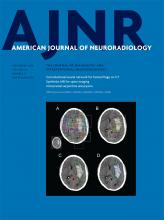Index by author
Wang, M.-L.
- Adult BrainOpen AccessLongitudinal Microstructural Changes in Traumatic Brain Injury in Rats: A Diffusional Kurtosis Imaging, Histology, and Behavior StudyM.-L. Wang, M.-M. Yu, D.-X. Yang, Y.-L. Liu, X.-E. Wei and W.-B. LiAmerican Journal of Neuroradiology September 2018, 39 (9) 1650-1656; DOI: https://doi.org/10.3174/ajnr.A5737
Wei, X.-E.
- Adult BrainOpen AccessLongitudinal Microstructural Changes in Traumatic Brain Injury in Rats: A Diffusional Kurtosis Imaging, Histology, and Behavior StudyM.-L. Wang, M.-M. Yu, D.-X. Yang, Y.-L. Liu, X.-E. Wei and W.-B. LiAmerican Journal of Neuroradiology September 2018, 39 (9) 1650-1656; DOI: https://doi.org/10.3174/ajnr.A5737
Weinberg, B.D.
- EDITOR'S CHOICEAdult BrainOpen AccessHybrid 3D/2D Convolutional Neural Network for Hemorrhage Evaluation on Head CTP.D. Chang, E. Kuoy, J. Grinband, B.D. Weinberg, M. Thompson, R. Homo, J. Chen, H. Abcede, M. Shafie, L. Sugrue, C.G. Filippi, M.-Y. Su, W. Yu, C. Hess and D. ChowAmerican Journal of Neuroradiology September 2018, 39 (9) 1609-1616; DOI: https://doi.org/10.3174/ajnr.A5742
This study evaluates a convolutional neural network optimized for the detection and quantification of intraparenchymal, epidural/subdural, and subarachnoid hemorrhages on noncontrast CT with a 10,159-examination training cohort (512,598 images; 901/8.1% hemorrhages) and an 862-examination test cohort (23,668 images; 82/12% hemorrhages). Accuracy, area under the curve, sensitivity, specificity, positive predictive value, and negative predictive value for hemorrhage detection were 0.975, 0.983, 0.971, 0.975, 0.793, and 0.997 on training cohort cross-validation and 0.970, 0.981, 0.951, 0.973, 0.829, and 0.993 for the prospective test set.
Weinstock-guttman, B.
- Extracranial VascularOpen AccessFive-Year Longitudinal Study of Neck Vessel Cross-Sectional Area in Multiple SclerosisL. Pelizzari, D. Jakimovski, M.M. Laganà, N. Bergsland, J. Hagemeier, G. Baselli, B. Weinstock-Guttman and R. ZivadinovAmerican Journal of Neuroradiology September 2018, 39 (9) 1703-1709; DOI: https://doi.org/10.3174/ajnr.A5738
Westmacott, R.
- FELLOWS' JOURNAL CLUBFunctionalYou have accessBreath-Hold Blood Oxygen Level–Dependent MRI: A Tool for the Assessment of Cerebrovascular Reserve in Children with Moyamoya DiseaseN. Dlamini, P. Shah-Basak, J. Leung, F. Kirkham, M. Shroff, A. Kassner, A. Robertson, P. Dirks, R. Westmacott, G. deVeber and W. LoganAmerican Journal of Neuroradiology September 2018, 39 (9) 1717-1723; DOI: https://doi.org/10.3174/ajnr.A5739
Twenty children (30 imaging sessions, 60 MR scans) with Moyamoya disease underwent dual breath-hold hypercapnic challenge blood oxygen level–dependent MR imaging of cerebrovascular reactivity studies in the same MR imaging session. Within-day, within-subject repeatability of cerebrovascular reactivity estimates, derived from the blood oxygen level–dependent signal, was computed. Breath-hold hypercapnic challenge blood oxygen level–dependent MR imaging is a repeatable technique for the assessment of cerebrovascular reactivity in children with Moyamoya disease and is reliably interpretable for use in clinical practice.
Wintermark, M.
- FELLOWS' JOURNAL CLUBAdult BrainYou have accessEvaluation of Thick-Slab Overlapping MIP Images of Contrast-Enhanced 3D T1-Weighted CUBE for Detection of Intracranial Metastases: A Pilot Study for Comparison of Lesion Detection, Interpretation Time, and Sensitivity with Nonoverlapping CUBE MIP, CUBE, and Inversion-Recovery-Prepared Fast-Spoiled Gradient Recalled Brain VolumeB.C. Yoon, A.F. Saad, P. Rezaii, M. Wintermark, G. Zaharchuk and M. IvAmerican Journal of Neuroradiology September 2018, 39 (9) 1635-1642; DOI: https://doi.org/10.3174/ajnr.A5747
The authors performed a retrospective review of 48 patients with cerebral metastases from June 2016 to October 2017. Brain MRIs included gadolinium-enhanced T1-weighted IR-FSPGR-BRAVO and CUBE, with subsequent generation of nonoverlapping CUBE MIP and overlapping CUBE MIP. Two blinded radiologists identified the total number and location of metastases on each image type. This study suggests that the use of overlapping CUBE MIP or nonoverlapping CUBE MIP for the detection of brain metastases can reduce interpretation time without sacrificing sensitivity, though the contrast-to-noise ratio of lesions is highest for overlapping CUBE MIP.
Witte, R.J.
- Head & NeckOpen AccessComparison of a Photon-Counting-Detector CT with an Energy-Integrating-Detector CT for Temporal Bone Imaging: A Cadaveric StudyW. Zhou, J.I. Lane, M.L. Carlson, M.R. Bruesewitz, R.J. Witte, K.K. Koeller, L.J. Eckel, R.E. Carter, C.H. McCollough and S. LengAmerican Journal of Neuroradiology September 2018, 39 (9) 1733-1738; DOI: https://doi.org/10.3174/ajnr.A5768
Wu, X.
- You have accessBlunt Cerebrovascular Injuries: Advances in Screening, Imaging, and Management TrendsA. Malhotra, X. Wu and K. SeifertAmerican Journal of Neuroradiology September 2018, 39 (9) E103; DOI: https://doi.org/10.3174/ajnr.A5733








